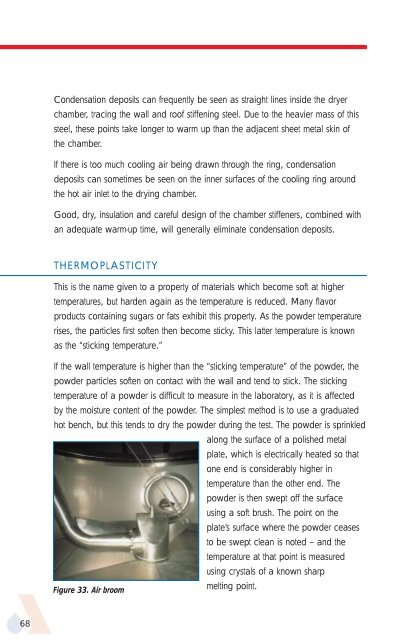APV Dryer Handbook - Umbc
APV Dryer Handbook - Umbc
APV Dryer Handbook - Umbc
You also want an ePaper? Increase the reach of your titles
YUMPU automatically turns print PDFs into web optimized ePapers that Google loves.
68<br />
Condensation deposits can frequently be seen as straight lines inside the dryer<br />
chamber, tracing the wall and roof stiffening steel. Due to the heavier mass of this<br />
steel, these points take longer to warm up than the adjacent sheet metal skin of<br />
the chamber.<br />
If there is too much cooling air being drawn through the ring, condensation<br />
deposits can sometimes be seen on the inner surfaces of the cooling ring around<br />
the hot air inlet to the drying chamber.<br />
Good, dry, insulation and careful design of the chamber stiffeners, combined with<br />
an adequate warm-up time, will generally eliminate condensation deposits.<br />
THERMOPLASTICITY<br />
This is the name given to a property of materials which become soft at higher<br />
temperatures, but harden again as the temperature is reduced. Many flavor<br />
products containing sugars or fats exhibit this property. As the powder temperature<br />
rises, the particles first soften then become sticky. This latter temperature is known<br />
as the “sticking temperature.”<br />
If the wall temperature is higher than the “sticking temperature” of the powder, the<br />
powder particles soften on contact with the wall and tend to stick. The sticking<br />
temperature of a powder is difficult to measure in the laboratory, as it is affected<br />
by the moisture content of the powder. The simplest method is to use a graduated<br />
hot bench, but this tends to dry the powder during the test. The powder is sprinkled<br />
along the surface of a polished metal<br />
plate, which is electrically heated so that<br />
one end is considerably higher in<br />
temperature than the other end. The<br />
powder is then swept off the surface<br />
using a soft brush. The point on the<br />
plate’s surface where the powder ceases<br />
to be swept clean is noted – and the<br />
temperature at that point is measured<br />
using crystals of a known sharp<br />
Figure 33. Air broom<br />
melting point.











